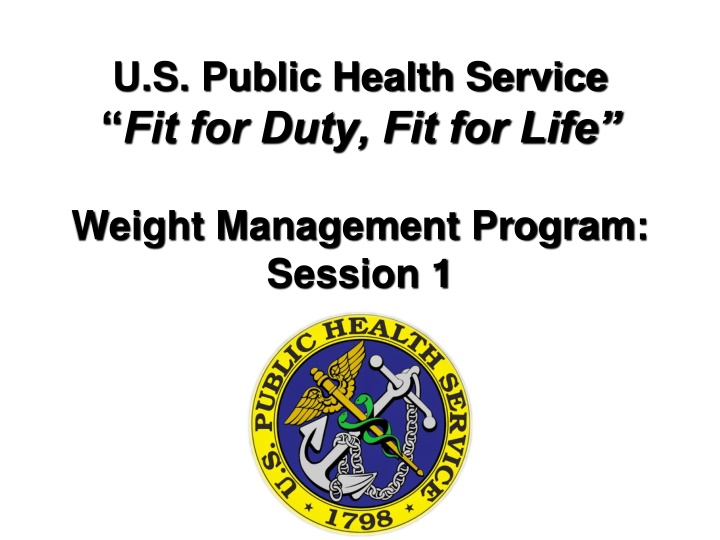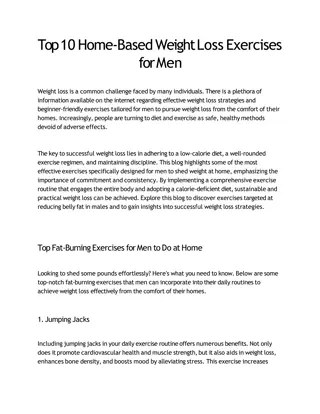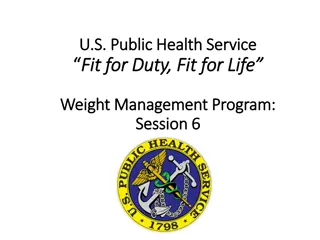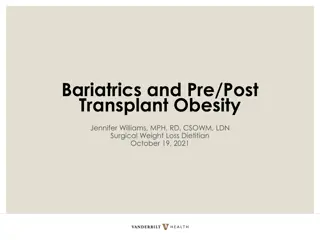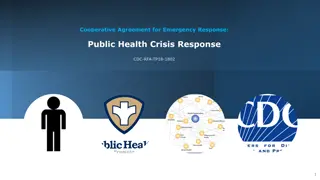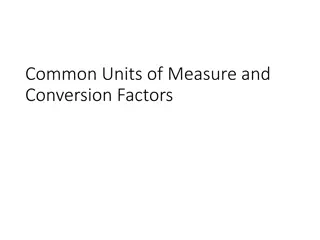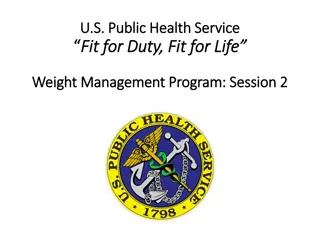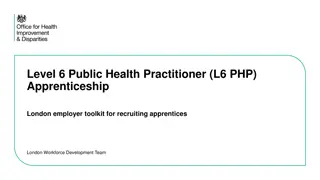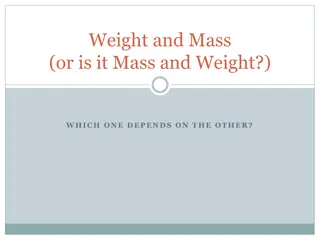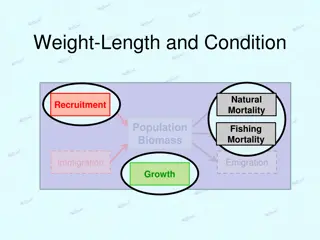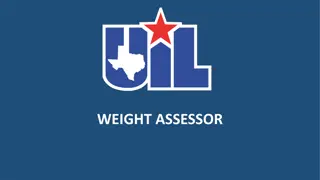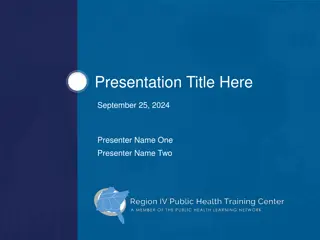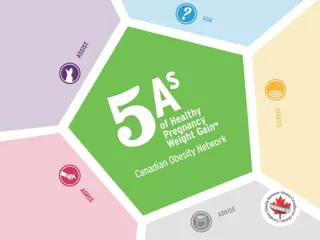U.S. Public Health Service Weight Management Program Overview
This weight management program, developed by dietitians/nutritionists in the U.S. Public Health Service, offers guidance on healthy weight loss and maintenance for service members. The program covers topics such as BMI calculation, goal setting, healthy eating habits, physical activity recommendations, and behavioral change strategies. Participants are expected to complete online modules, make lifestyle changes, and engage in discussions to achieve their goals throughout the six sessions. The course aims to educate individuals on understanding body weight, setting weight loss goals, and finding reputable resources to support their weight loss efforts.
Download Presentation

Please find below an Image/Link to download the presentation.
The content on the website is provided AS IS for your information and personal use only. It may not be sold, licensed, or shared on other websites without obtaining consent from the author.If you encounter any issues during the download, it is possible that the publisher has removed the file from their server.
You are allowed to download the files provided on this website for personal or commercial use, subject to the condition that they are used lawfully. All files are the property of their respective owners.
The content on the website is provided AS IS for your information and personal use only. It may not be sold, licensed, or shared on other websites without obtaining consent from the author.
E N D
Presentation Transcript
U.S. Public Health Service Fit for Duty, Fit for Life Weight Management Program: Session 1
Introduction to the Program These sessions were developed by a group of dietitians/nutritionists in the Commissioned Corps of the U.S. Public Health Service. The sessions were designed for the USPHS and other uniformed service members seeking general information and guidance regarding healthy weight loss and weight maintenance. These sessions are not meant to substitute for individual recommendations from your personal health care provider(s).
What you should expect to learn in this series Understand body weight, overweight, and obesity; and how they relate to your health and fitness Set an appropriate weight loss goal Learn ways to change your eating habits and physical activity to achieve your weight loss to maintain a healthy weight to improve your health Learn how to find reputable resources to assist your with your weight loss efforts
What will be expected cont. Complete all of the online modules in this series Be willing to make lifestyle changes to reach your goals Complete all class assignments to reinforce learning Participate in any on-line discussions Enjoy and learn!
Course Overview: Series of 6 sessions Session 1: Course overview Determining your BMI and related health risks Setting weight loss and physical activity goals Keeping food and activity records Session 2: Calories and caloric density Healthy and not-so-healthy foods from each food group Meal replacements Healthy eating during deployments
Course Overview cont. Session 3: Physical activity recommendations Healthy low-calorie food preparation Session 4: Controlling portion sizes Reading and using food labels Tips for eating out
Overview cont. Session 5: Behavioral change Tips for losing weight and keeping it off Staying on track Session 6: Reflecting on how your efforts are working for you Evaluating weight management programs and options Wrap up and encouragement for continued success
Topics for Today Introduction: why weight management is important to us as commissioned officers Understanding Body Mass Index (BMI) and how to calculate your BMI Setting a weight loss target goal Keeping food and activity records Looking for patterns Setting effective goals
Americans are tipping the scales Over two thirds of U.S. adults are overweight 35.7% of U.S. adults- were obese in 2009- 2010 Estimated total cost of obesity in the U.S. was $147 billion in 2008 dollars
Why is a healthy weight important? As an individual your personal health and well-being As an officer in the U.S. PHS
Health benefits of attaining and maintaining a healthy weight Decreased risk for developing: heart disease high blood cholesterol high blood pressure type 2 diabetes gallbladder disease some gynecologic disorders Osteoarthritis some types of cancer Increased energy Improved feeling of well-being
Healthy Weight and Officership Healthy weight is related to physical fitness Officers at a healthy weight: are better able to meet physical fitness requirements for force readiness optimally function in deployment roles serve more effectively as positive examples and ambassadors of health improve their uniform aesthetics
Factors Influencing Body Weight Genes Metabolism Behavior Environment Height Physical activity Energy In = Energy Out
Aim for a Healthy Weight This booklet for adults contains practical, easy-to-use information for losing and maintaining weight: tips on healthy eating and physical activity setting weight loss goals and rewarding success other options such as weight loss medications and weight loss surgery portion and serving size information sample reduced calorie menus tips on dining out a sample walking program weekly food and activity diary, and more.
Assessing Risk: BMI (Body Mass Index) BMI is used to estimate body fatness and risk for associated diseases correlates well with disease risk is easy to calculate
BMI Chart A picture of the Body Mass Index chart that shows height on vertical axis and pounds on horizontal axis. The three columns of the chart are healthy weight, overweight, obese
Calculating Your BMI: 1. Multiply your weight (in pounds) by 703 2. Divide the answer in step 1 by your height (in inches) 3. Divide the answer in step 2 by your height (in inches) to get your BMI Example: For someone who weighs 175 lbs and is 5 7 the calculation would be as follows: 175 x 703 = 123025 123025 67 = 1836 1836 67 = 27.4 (BMI)
BMI Charts BMI Categories: Underweight Normal weight Overweight Obesity less than 18.5 18.5 - 24.9 25 - 29.9 30 or more BMI Calculators can be found online Other tools to determine disease risk: http://hp2010.nhlbihin.net/atpiii/calculator.asp?user type=pub
But BMI isnt perfect BMI is an imperfect measurement of body fatness. Very muscular individuals may have a BMI in the overweight or obese range even though they may be lean. Individuals may be overfat, but still have a BMI in the normal range. Other methods of assessing body fat are available.
Aging and Body Composition Total body fat increases slowly, peaking at around age 50-60. Lean mass decreases, starting at about age 30. Fat distribution changes with age (more fat in the abdominal area). These changes vary by sex and race/ethnicity and may be associated with decreased physical activity and menopausal status.
Waist Circumference Waist circumference is also an important measurement to help you figure out your overall health risks. If most of your fat is around your waist, then you are more at risk for heart disease and diabetes. This risk increases with a waist measurement (measured just above your hipbone) that is: > 35 inches for women > 40 inches for men
How much weight should I aim to lose? If you are overweight or obese, weight loss of 5-10% can result in significant health benefits. Determine how many pounds you would need to lose. 5% of your weight: ____ 10% of your weight: ____ Is this a reasonable initial goal for you?
Step One: Keep records To gain insight into your current eating and physical activity habits... Record what you eat and drink Record your physical activity for 3-7 days
Focus this coming week Record: All foods and drinks The time The place home, work, restaurant (name), friend s home, in car, etc. The name of each food and beverage consumed The amount consumed All physical activities Name of activity Intensity Number of minutes
Example of a food/activity log Time Place Food/Beverage Amount Physical Activity 7 a.m. Home Orange Juice 6 ounces Glazed donut 2 Coffee with sugar 16 ounces 7:45 a.m. Walked to train (20 minutes) 10 a.m. Work Granola bar 1
Step Two: Analyze your eating and exercise habits Look for patterns: How many times per day do you eat? When and where are you likely to overeat? What foods are problem foods for you? How many minutes per week are you physically active? How do weekdays compare to weekend days?
Step Three: Set effective goals Focus on dietary and exercise changes that lead to permanent weight loss. Behavioral lifestyle change goals Effective goals are: Specific and measurable Realistic Forgiving (less than perfect)
Whats wrong with these goals? I will lose weight. I will lose 10 pounds this week. I will eat more fruits and vegetables. I will jog 2 hours every morning before work. I won t eat any desserts - ever!
Characteristics of effective goals Specific Not exercise more Instead walk briskly Measurable Not more often Instead for 30 minutes and 5 days this week Realistic Not every day , Instead 5 days this week Forgiving Not 2 hours Instead 30 minutes [or 15 minutes ]
Setting effective goals: an example I will exercise more. Better I will walk every day. Even Better I will walk 30 minutes each day. Best!! I will walk briskly 30 minutes, 5 days this week.
Effective goals: specific, measurable, realistic, forgiving I will walk briskly at least 30 minutes at least 5 days this week. I will eat 2 servings of fruit each day for at least 5 days this week. I will limit my TV watching to no more than 1 hour on week nights. I will take my lunch to work 3 days this week. I will not eat anything between lunch and my [planned] afternoon snack
Summary of todays session Introduction and course overview Understanding BMI and how to calculate your BMI Setting a weight loss target goal Keeping food and activity records Looking for patterns Setting effective goals
Assignments for the next session 1. Determine your BMI. 2. Set your initial weight loss goal. 3. Keep food and activity records. 4. Set 2 or 3 behavioral goals.
